铚傝湝寮哄寲楗煎共中鐗╂€ф娴?IndustryName1=检测方案(质构仪)
检测样品 铚傝湝寮哄寲楗煎共
检测项目 鐗╂€ф娴?IndustryName1=

 银牌会员
18 篇解决方案
银牌会员
18 篇解决方案
方案详情文
智能文字提取功能测试中
Advances in Bioresearch2obancestnTioresearchAdv. Biores., Vol 5 (1) June 2014:93-101C2014 Society of Education, IndiaPrint ISSN 0976-4585;Online ISSN 2277-1573Journal's URL:http://www.soeagra.com/abr.htmlCODEN: ABRDC3ICV 7.20 [Poland] Dave et al ORIGINAL ARTICLE Antioxidant Activity, Textural Properties and Storage Stability ofHoney Fortified Biscuits Neeta Dave1, Ila Patel2, Vinayak Patel3 1*P.G. Department of Home Science, Sardar Patel University, Vallabh Vidyanagar, Gujarat, India 2P.G. Department of Home Science,Sardar Patel University, Vallabh Vidyanagar, Gujarat, India 3 P.G. Department of Home Science, Sardar Patel University, Vallabh Vidyanagar, Gujarat, India E-mail :neeta_dave2004@yahoo.com ABSTRACT Honey is a supersaturated solution of sugars, which contains more than 180 other constituents like enzymes, amino acidsand organic acids, carotenoids, Maillard reaction products, vitamins, minerals and polyphenols The objective of thisstudy was to evaluate the effect ofaddition of honey on the sensorial attributes, total antioxidant capacity and texturalproperties of biscuits. The stability of the formulation during a one month storage period was also checked. To fulfill theobjectives control and honey fortified biscuits were prepared in the laboratory. The biscuits were evaluated for theirtotal phenols and total antioxidant capacity (from water and methanol extract of biscuits].Rheological properties fromthe biscuit dough and textural properties of control and honey fortified biscuits were also studied. Overall quality ofcontrol and 5% honey incorporated biscuits showed a better score as compared to 10 and 15% level ofincorporation.The biscuits were stored for a period ofone month and were analyzed for peroxide value on 15th and 30th day of storageperiod. The total phenolic content and total antioxidant activity of biscuits increased as the level of honey incorporationwas increased. Methanolic extract showed higher total antioxidant activity as compared to water extract. The firmnessofdough for control & experimental biscuits ranged from 8.68 -19.55 kgf. Addition of 5gms honey produced significantlyhigher (P s.05) firmness as compared to control (12.16 kgf) & 15gms honey fortified biscuits (8.68 kgf). Addition ofhoneyincreased the adhesiveness from 0.12 (10gm honey biscuit) to 0.17kgf. mm (15gms honey biscuit). Honey incorporatedsamples showed a significant reduction in lipid peroxidation after 15th and 30th day ofstorage. Thus honey appears to bea good source of natural antioxidants, improves the textural properties of biscuits and can be used to prevent lipidoxidation in biscuits. Keywords: Honey, Total Antioxidant activity, Biscuits, Total Phenols Received 09/01/2014 Accepted 22/05/2014 @2014 Society ofEducation, India How to cite this article: Neeta D, Ila P, Vinayak P.Antioxidant Activity, Textural Properties and Storage Stability of Honey Fortified Biscuits.Adv. Biores.,Vol 5 [2] June 2014: 93-101. DOI: 10.15515/abr.0976-4585.5.2.93-101 INTRODUCTION Long shelf-life of biscuits makes large scale production & distribution possible. Biscuits present a fastgrowing segment of food in India because of consumer demands for convenient and nutritious foodproducts. The consumers demand has increased for the quality food products with taste, safety,convenience and nutrition. Thus nutrition has emerged as an added dimension in the chain of foodproduct development [1]. Oxidation is one of the most important processes occurring in food systems. It affects many interactionsamong food constituents, leading to both desirable and undesirable products. Food lipids are foodscomponents that are very susceptible to oxidation processes, therefore oxidation reactions are one of themajor sources of deterioration that occurs during manufacturing, storage, distribution and finalpreparation of foods [2].Oxidative changes in foods include not only development of off-flavors, but alsoloss of color, nutrient value, and more importantly, the accumulation of deleterious compounds, whichmight be connected with higher incidence and mortality rates of numerous human illnesses, such ascancer, atherosclerosis, and heart disease. Therefore, the keeping quality of baked food such as biscuits,which often contain considerably high amounts of lipid, is of great nutrition and economic importance, since these products are widely used and often stored for extended periods before consumption [3]. Theoxidation of fats and oils can be prevented or even delayed by antioxidants [4]. Honey has been used as a food and medical product since the earliest times. It is a natural substanceproduced by honeybees, Apis mellifera, from the nectar of blossoms or from exudates of trees and plantsgiving nectar honeys or honeydews, respectively. As the only available natural sweetener, honey was animportant food for Homo sapiens from his very beginnings. Indeed, the relationship between bees andman started as early as the Stone Age [5]. On an estimate, about 80% of honey is used directly inmedicines and 10% is used in Ayurvedic and pharmaceutical production. Five species of honey bees arefound all over the world, namely Apis florea, A. cerana, A. dorsata, A. mellifera and Trigona iridipennis.However, A. cerana and A. mellifera are reared in hives in India (Singh, 2007). Historically, honey was asource of sugar for thousands of years, it has the advantage of a natural origin, and confers a particularflavor to the foods in which it is included [6]. Antioxidant activity, or simply antioxidant capacity, is the ability and potential of honey to reduceoxidative reactions within the human health and food systems. Notably, these oxidative reactions cancause deleterious reactions in food products [e.g., lipid oxidation in meat, and enzymic browning in fruitsand vegetables) and adverse health effects, such as chronic diseases and cancers [7].The antioxidants thatnaturally occur in honey contribute to its antioxidant capacity. These compounds are flavonoids, phenolicacids and some enzymes (e.g., glucose oxidase, catalase), ascorbic acid, carotenoid-like substances,organic acids, maillard reaction products, amino acids and proteins [8] found that while phenoliccompounds contribute significantly to the antioxidant capacity of honey, they are not solely responsiblefor it. However, the antioxidant capacity varies greatly depending on the honey floral source, possibly dueto the differences in the content of plant secondary metabolites and enzyme activity. The objective of thisstudy was to optimize the level of honey in biscuit formulation and evaluation of total antioxidantcapacity of the biscuits. The effect of addition of honey on the textural properties and the stability ofbiscuits during a one month storage period was also studied. MATERIAL AND METHODS Procurement of raw material All the raw materials for the preparation of control and experimental biscuits mentioned in table 1 werepurchased from the local market of Vallabh Vidyanagar. Control biscuits were prepared by the methodgiven in AACC [9].Experimental biscuits were prepared by addition of honey at a level of 5, 10 and 15%. Preparation of biscuits The control biscuits were prepared basically using the rubbing method. The refined wheat flour, glucosepowder and skimmed milk powder were mixed and sieved twice to ensure uniform homogenousblending as 'Dry mix. The vanaspati ghee was creamed till light and fluffy. To this sugar powder wasgradually added,continuing the creaming process till the mixture became light. Salt, sodium bicarbonateand ammonium bicarbonate were dissolved in small quantity of water and mixed into ghee-sugarmixture, followed by addition of essence. This mixture is termed as"paste’. The Dry mix’ was added to'paste' gradually, mixed gently and kneaded into smooth dough. The dough was sheeted on the platformto a thickness of 0.5 cm using a wooden rolling pin. The dough-sheet was cut into circular shape using ametallic cutter of 5 cm diameter. Each raw biscuits was transferred and systematically arranged on abaking sheet about 10 mm apart from each other. The tray was transferred, as quickly as possible, to apreheated baking oven (Bajaj Ltd) at 180°c and baked for 7 minutes. The biscuits were immediatelytransferred on a container having holes on the surface for cooling. The cooled biscuits were packed inaluminum foil. The experimental biscuits were also prepared by similar method except that varying levelsof honey was incorporated in it. The composition of control and experimental biscuits are presented inTable.1. Rheological analyses of biscuit dough and textural properties of control and honey fortifiedbiscuits The rheological analyses of dough of control and experimental biscuits as well as the textural propertiesof control and honey fortified biscuits were performed using a food texture analysis System"Lloyd LFplus and Nexygen Software" (Lloyd Instruments Ltd., U.K.) model TA500. Sensory evaluation Sensory evaluation of the control and experimental biscuits was carried out by a team of six panelmember using composite scoring test [10]. The control and experimental biscuits were evaluated forvarious visua nl sensory attributes like color, surface character, crumb color, crumb texture, taste,mouth feel and overall quality. Determination of total phenols The total phenols were analyzed by the method described by Singleton et al [11]. 1 gm powder of control and experimental biscuits were taken in separate beakers. To all of these 25 ml of0.3 N HCL was added and shaken for about 1 hour followed by centrifugation at 8000 rpm for about 10minutes. The supernatant obtained was evaporated to dryness in a vacuum dryer at 40° C. The residuewas dissolved in hot water in a volumetric flask to a known concentration. 0.05 ml from the above samplewas taken as an aliquot. To this 0.5 ml of Folin-Ciocalteu reagent (diluted 1:1) was added. The contentwas cyclomixed for 4 min and 10 ml sodium carbonate was added. Content was made upto 12 ml withdistilled water and allowed to incubate for 1 hour at room temperature. Standard series of knownconcentration of gallic acid (5-20pg) were prepared and to this 0.5 ml of Folin-Ciocalteu reagent (diluted1:1) was added and there after treated in same way as sample. The colour intensity was measured at 750nm on a UV spectrophotometer. Determination of Total Antioxidant Capacity It was determined using Ferric Reducing Antioxidant Power Assay as per the method described given byBenzie and Strain [12]. 1gm of sample was taken and volume was made to 40 ml with distilledwater/methanol and mixed well. It was then filtered through whatman no. 1 filter paper. 100 pl of abovealiquot was taken in a test tube and volume was made up to 300 pl with distilled water/methanol. 1.8 mlof Ferric Reducing Antioxidant Power (FRAP) working reagent was added and the contents wereincubated at 37° C for 10 minutes. Standard series of known concentration of trolox (1-4ug), gallic acid(0.2-0.8 ug)ascorbic acid (1-4ug) were taken and the volume was made up to 300pl with distilled water.There after all three tubes were treated in the same way as sample.The absorbance was read at 593 nmusing the double beam UV Spectrophotometer (Hitachi, Japan model 2205). Determination of Peroxide value Peroxide value was estimated from the fat that was extracted from control and experimental biscuits at 0,15th, and 30th day of storage by gravimetric solvent extraction procedure according to soxhlet method.Rancidity tests were carried out by following method. The method adopted for estimation of peroxidevalue was the one prescribed by Sadasivam [13].5 gm oil sample was weighed in a 250ml glass stopperconical flask. 30 ml of acetic acid:chloroform (3:2 by volume) mixture was added followed by addition ofpotassium iodide solution. The solution was swirled for exactly one minute and then 30ml distilled waterwas added.Finally the content of flask was titrated with standard 0.01 N sodium thiosulphate solutionwith constant and vigorous shaking using freshly prepared starch solution used as an indicator. Titrationwas continued until the yellow color almost disappeared. Then 2 ml starch solution was added. Thetitration was again continued by drop wise addition of standard 0.01 N sodium thiosulphate solution till itshowed a change in color from blue violet to colorless. Statistical analysis Three replicates of each sample were used of statistical analysis and the values were reported as mean ±SD. Pearson’s correlation and One-way ANOVA with Duncan’s multi-variant analysis were carried outusing SPSS, version 16.0 software. RESULTS AND DISCUSSION The mean values of rheological properties of dough for control & experimental biscuits are presented intable 2. The firmness of dough for control & experimental biscuits ranged from 8.68 -19.55 kgf. Additionof 5gms honey produced significantly higher (P≤ 0.05) firmness as compared to control (12.16 kgf) &15gms honey fortified biscuits (8.68 kgf). The firmness of 10gms honey fortified biscuits was 10.27 kgfwhich was found to be non significantly lower (P≤ 0.05) than the control biscuits & significantly higher (P≤ 0.05) than 15gms honey fortified biscuits. Frank & Mathew (1999) also found a non significant decreasein firmness of muffins as the level of honey was increased. A significant difference (P ≤ 0.05) was found infirmness between dough prepared with water, honey, lemon juice or honey / lemon juice [14]. Theadhesiveness of dough of control & experimental biscuits ranged from 0.10 (control) to 0.17 kgf. mm(15gms honey biscuit). Addition of honey increased the adhesiveness from 0.12 (10gm honey biscuit) to0.17kgf. mm (15gms honey biscuit). 5gms honey fortification in biscuit dough had 0.15 kgf. mmadhesiveness. The results are in agreement with few researches (Frank & Mathew, 1999) in which theyhad demonstrated an increase in adhesiveness of the product with the addition of honey. Thecohesiveness of dough of control & experimental biscuits ranged from 0.01 (10gm honey biscuit) to 0.53(15gms honey biscuit). Addition of 15gms honey to the dough showed a significantly higher (P ≤ 0.05)value compared to all other samples. At 10gms level honey produced the least cohesiveness. Controlbiscuits showed a value of 0.06 which was near to the value obtained by 5gms honey incorporatedbiscuits. No specific trend was observed upon increasing the level of honey in the dough. Frank & Mathew[15] also reported an increase in cohesiveness of muffins by incorporating honey in muffins. The springiness ranged between 0.59 and 0.83 mm. Dough containing 5 (0.62mm) & 15gms (0.62mm) honeyexhibited similar springiness. Maximum springiness was observed in the dough having 10gms of honeywhile 5gms honey fortified dough had the least springiness among the honey fortified dough. The resultsare in agreement with the results reported by Qunyi et al [16]. These researchers found an increase in thespringiness of bread as honey powder was increased up to 10% honey powder / flour level. Table 1: Composition of control and experimental biscuits Ingredients Product A B C D Refined wheat flour (gm) 100 100 100 100 Sugar powder (gm) 30 25 20 15 Fat (gm) 25 25 25 25 Essence (ml) 0.2 0.2 0.2 0.2 Skimmed milk powder (gm) 2.0 2.0 2.0 2.0 Glucose (gm) 2.0 2.0 2.0 2.0 Salt (gm) 1.0 1.0 1.0 1.0 Ammonium bicarbonate (gm) 1.0 1.0 1.0 1.0 Sodium bicarbonate (gm) 0.5 0.5 0.5 0.5 water(ml) 20 20 23 26 Honey (gm) 一 5 10 15 A - Control biscuits B-5 gm honey fortification C -10 gm honey fortification D -15 gm honeyfortification Table 2: Rheological properties of dough prepared for control and experimental biscuits Product Firmness(kgf) Adhesiveness(kgf.mm) Cohesiveness[kgf.mm) Springiness(mm) A 12.16b±0.06 0.10a±0.05 0.06b±0.013 0.59a±0.13 B 19.55c±0.29 0.15ab±0.01 0.08b±0.00 0.62a±0.01 C 10.27bc±1.09 0.12ab±0.00 0.01a±0.00 0.83b±0.16 D 8.68a±0.38 0.17b±0.03 0.53c±0.46 0.62a±0.02 F-value 64.37* 3.31 294.93* 3.43 Values are Mean± SD of three determinations Means bearing the same superscripts within the column do not differ significantly (Ps0.05) *Indicates significant difference at (P ≤ 0.05) A- Control biscuits, B-5 gm honey fortified biscuits, C -10 gm honey fortified biscuits D - 15 gm honeyfortified biscuits Table 3: Sensory scores of control and experimental biscuits Product Color Surfacecharacter Crumbcolor Crumbtexture Taste Mouthfeel Overallquality A 6.42a±0.23 6.17ab±0.27 6.29c±0.28 6.46c±0.23 6.67d±0.19 6.42b±0.29 6.67c±0.19 B 6.54a±0.19 6.58b±0.15 6.13bc±0.20 5.75±0.24 5.88c±0.30 5.58b±0.31 6.21c±0.16 C 6.04b±0.22 5.88a±0.21 5.24b±0.25 4.42b±0.31 5.00b±0.30 4.17a±0.47 4.79b±0.33 D 5.29a±0.34 4.88a±0.26 4.58a±0.31 3.38a±0.36 3.96a±0.29 3.21a±0.41 3.46a±0.27 F-value 5.058* 10.58* 8.9* 22.20* 17.91* 14.30* 34.50* Values are Mean ± SD scores of a composite scoring test by a panel of 6 members x2 replications Table 4: Texture analysis of control and experimental biscuits Product Maximum Load(N) Maximum Deflection(mm] Fracture Stress(N/m) Fracture strain(%) A 14.01±0.76 1.37±0.89 b430793.33±73013.83 0.03 ±0.00 B 10.16±0.64 1.40±0.02 4b00746.67 ±18607.31 0.02±0.00 C 5.58 ±0.66 1.71 ±0.03 230046.67 ±16076.15 0.03±0.00 D 3.56±0.26 3.05±0.06 139286.67±10997.43 0.05±0.00 F-value 176.90* 199.17* 12.76* 53.77* Dave et al Values are Mean ± SD of three determinations Means bearing the same superscripts within the column do not differ significantly (P ≤0.05) *Indicates significant difference at (P ≤ 0.05) A - Control biscuits, B-5 gm honey fortified biscuits, C-10 gm honey fortified biscuits D-15 gm honeyfortified biscuits Fig. 1 Total phenolic content of control and honey fortified biscuits expressed as Gallic acid Equivalent (GAE) Bars not sharing the same superscripts are significantly different (P ≤ 0.05) Fig.2: TAC (equivalent to Trolox) of Methanol (M) and Water (W) extract of control and honey fortifiedbiscuits Bars sharing the same superscripts are significantly different Fig 3:Peroxide value of control and honey fortified biscuits on day 0Bars not sharing the same superscripts are significantly different (P ≤ 0.05) Fig 4:Peroxide value of control and honey fortified biscuits on day 15Bars not sharing the same superscripts are significantly different (P ≤ 0.05) Fig 5: Peroxide value of control and honey fortified biscuits on day 30Bars not sharing the same superscripts are significantly different (P ≤ 0.05) The mean scores of different sensory attributes obtained are presented in table 2. It was observed that5gm honey fortified biscuits showed a higher score of color (6.54) compared to the control biscuits (6.42).15gms honey fortified biscuits had significantly lower (P ≤ 0.05] score for color (5.29] as compared to 5 &10gms (6.04) honey supplementation.Addition of 5gms honey significantly (Ps 0.05) improved thescore for surface character (6.58] as compared to control (6.17) as well as 10gms (5.88] & 15gms (4.88)honey fortified biscuits. A non significant difference was observed between the crumb color scores of thehoney incorporated biscuits. At 5, 10 & 15% level of incorporation the scores obtained are 6.13, 5.24 &4.58, respectively. All these scores were significantly lower (P ≤ 0.05) than the score obtained for controlbiscuits (6.29). Highest score for crumb texture was exhibited by the control biscuits (6.46) followed by5gms (5.75], 10gms (4.42) & 15gms (3.38) honey incorporated biscuits. Similar trend was observed fortaste scores of control & experimental biscuits. Control biscuits had significantly higher (P ≤ 0.05) score(6.67) for taste than the experiment biscuits. A non significant difference in taste score was observedwhen honey was incorporated at a level of 10gm (5.00) & 15gm (3.96). 5gms honey supplementationimproved the taste score (5.88] of biscuits as compared all the other samples. The mean values of textural properties of control and honey incorporated biscuits is depicted in table3.Control biscuits had significantly higher (P ≤ 0.05) "maximum load” (14.01 N) as compared to theexperimental biscuits. Increasing the level of honey decreased the maximum load. 5gms honey fortifiedbiscuits had significantly higher (P ≤ 0.05) maximum load (10.14 N) as compared to 10gm (5.58 N) &15gms (3.56 N) honey fortified biscuits. Decrease in “"maximum load" on increasing the level of honeymay be attributed to increased water content of honey fortified biscuits."Maximum deflection" was foundto be significantly higher (P ≤ 0.05) in 15gms honey fortified biscuits (3.05mm] as compared to the otherbiscuits. Increasing the level of honey significantly increased (P ≤ 0.05)the “maximum deflection. Asignificant difference (P≤ 0.05) was observed in the "maximum deflection”values among different experimental biscuits. 5gms and 10gms honey fortified biscuits showed a value of 1.40mm and 1.71mm,respectively. A non significant difference was observed in the "maximum deflection" values of control(1.37mm] & 5gms honey fortified biscuits (1.40 mm). Fracture stress for control & experimental biscuitsranged from 139286.67 to 430793.3 N/m2. Control biscuits (430793.3 N/m2) and 5gms honey fortifiedbiscuits (400746.67 N/m2) were not significantly different (P ≤ 0.05). Thus these biscuits wereconsidered similar when the effect of 5gms honey fortification in biscuits was analyzed. Addition of 10(230046.67 N/m2) & 15gms (139286.67 N/m2) honey decreased the fracture stress of biscuits. Control(0.03%) as well as 5gm (0.02%) and 10gm (0.03%) honey fortified biscuits did not show significantdifference (P ≤ 0.05) between each other in the fracture strain property while 15gms honey fortifiedbiscuits showed a significantly higher (P ≤ 0.05) value (0.05%) as compared to the other biscuits.Therefore the effect of addition of honey in biscuits at 5 & 10gms level was similar. Addition of 15gmshoney significantly (P≤0.05) increased the fracture strain of biscuits compared to all the biscuits tested.Biscuits containing 5gms honey had the lowest fracture strain, being more brittle & friable than thecontrol biscuits and biscuits containing 10 & 15gms honey (Table 2). Paula & Lupano [17] reported a nonsignificant difference (P≤0.05) in the fracture stress for biscuits with water, honey, lemon juice or lemonjuice honey. The same author has reported a significant difference in the fracture strain of biscuitsprepared with water, honey,lemon juice or honey / lemon juice. The mean values of total phenolic content of control and honey fortified biscuits is depicted in Figure 1.The highest value ( significant difference at P ≤ 0.05 level) was observed in 10gms honey fortifiedbiscuits ( 143.19 mg GAE/100gm) followed by 15gms honey fortified biscuits (131.50 mg GAE/100gm),5gms honey fortified biscuits (129.31 mg GAE/100gm) and control biscuits (120.60 mg GAE/100gm).5gms and 15gms honey fortified biscuits did not differ significantly (P≤ 0.05) in their total phenol values.Honey shows great potential to serve as an antioxidant in an emulsion system. Honey has beenincorporated into meat matrices to inhibit lipid oxidation [18] as well as to prevent browning reactions infruits & vegetables. Polyphenols, including flavonoids and phenolic acids, are found in honey, and thesecompounds act as free radical scavengers, peroxy radical scavengers, and as metal chelators [19, 20]. Thecharacteristic polyphenols present in honeys that are able to perform the role of biomarkers areflavonoids such as hesperetin, kaempferol, quercetin and chrysin, and phenolic acids: abscisic, ellagic, p-coumaric, gallic and ferulic [21,22]. The TAC values of methanolic extract equivalent to Trolox (ugTE/100gm) ranged between 109.71(control) and 236.79 ugTE/100gm (15gm honey fortification). 15gms honey fortified biscuits hadsignificantly higher (P≤ 0.05) value as compared to all other biscuits studied. Increasing the level ofhoney increased the TAC values of biscuits. A TAC value of 150.72 & 161.57 ugTE/100gm were observedin 5 & 10gms honey fortified biscuits, respectively. A range of 76.24 to 111.50 ugTE/100gm of TAC ofwater extract was observed among control & experimental biscuits.15gms honey fortified biscuits hadthe maximum value (111.50 ugTE/100gm] while the least value (76.24 ugTE/100gm] was observed inthe control biscuits. A little variation was observed in the TAC values of 5gm (97.96 ugTE/100gm) &10gm (103.10 ugTE/100gm) honey fortified biscuits (Fig. 2). From the above results it appears that withthe increase in the level of honey there is an increase in the total antioxidant capacity of biscuits. Furtherthe methanolic extract of control & experimental biscuits exhibited higher total antioxidant capacitycompared to water extract of their counterparts. The difference may be due to the fact that type of solvent& polarity affects the single electron transfer & the hydrogen atom transfer, which are the key aspects inthe measurements of antioxidant capacity [23]. Many researchers have demonstrated the influence ofsolvents by FRAP assay [24, 25]. They have also reported a higher FRAP value of methanolic extract ofcertain pure antioxidants as compared to the water extract. Biscuits containing 15 gms honey had thehighest antioxidant content & also was most effective in preventing lipid oxidation. Mckibben andEngeseth [26] have also demonstrated that honey was much more effective in preventing lipidperoxidation in ground turkey in comparison to butylated hydroxytoluene & tocopherol. The oil extracted from different sample after 15 & 30 days of storage in polyethylene bags at roomtemperature was used to investigate the efficiency of various concentration of honey at reducing lipidoxidation. Initially (Day 0) the peroxide values (Fig.3] ranged from 0.138 to 0.144 m equ./kg. Samplecontaining 5 & 15gms honey had an initial peroxide value of 0.138 m equ./kg respectively showing a nonsignificant difference between each other. Control sample had a peroxide value of 0.143 mequ./kg. After15 & 30 day of storage the peroxide value ranged from 5.51 to 16.78 m equ./kg & 9.77 to 24.27 mequ./kgrespectively (Fig.4 & 5, respectively). As the total antioxidant capacity of honey was increased in thesamples the lipid peroxidation also decreased. At day 15 & 30 the peroxide value of control sample hadmaximum lipid peroxidation (16.78 & 24.27 m equ./ kg, respectively) while on the same days 15gmshoney containing biscuits had least peroxide value of 5.51 & 9.77mequ./kg, respectively. At 10gms level of honey the peroxide value at 15 & 30 days was found to be 9.98 & 13.60 m equ./kg, respectively.Significant differences (P ≤ 0.05) in peroxide value were observed between biscuits prepared withouthoney and with different levels of honey. Biscuits containing 15 gms honey had the highest antioxidantcontent & also was also found to be most efficient in preventing lipid oxidation. Foods can be subjected tosome chemical changes during thermal treatment. One of them is the non-enzymatic browning due tomaillard reaction which occurs when sugars condense with free amino acids and leads to the formation ofa variety of brown pigments [27]. Antony et al [28] reported that when honey was added to turkey breastmeat before heating, it had an antioxidative effect on the meat which was attributed to maillard reactionproducts. The final stage of maillard reaction is characterized by the formation of nitrogen containingbrown pigment melanoidin [29]. Katrina [30] reported that polyphenols are involved in honeymelanoidin formation and that the presence of phenols in melanoidin provided melanoidins withantioxidant activity brought by phenolics. In the presnt study the maillard browning was higher as theconcentration of honey was increased in the biscuit which was evident from the colour of the biscuits. Asmentioned earlier the products that are formed from maillard browning act as antioxidant. Therefore inthe present study these maillard products in combination with honey antioxidants might have reducedlipid peroxidation in honey incorporated biscuits. CONCLUSION The textural properties of biscuits indicated that the control biscuits had significantly higher (P<.05)"maximum load"compared to the experimental biscuits. Increasing the level of honey decreased the"fracture stress". Incorporation of honey at 15gm% level increased the "fracture strain" of the biscuits,being more resistance to breakage than other types of biscuits. Biscuits having 5gms honey exhibitedbetter color and surface character attributes. Incorporation of honey at 15gm% level increased the totalantioxidant activity of biscuits when expressed as equivalent to trolox .Total phenolic content was foundto be highest at 15 gms of honey supplementation. Addition of honey in biscuit reduced lipid peroxidationafter 15th and 30th day of storage. The capacity to reduce peroxide formation in biscuit samples increasedwith increasing the antioxidant capacity of honey. 15% level of honey incorporation was the mosteffective in preventing lipid oxidation. Thus honey can be used as a nutraceutical ingredient in thepreparation of biscuits. REFERENCES ( 1. Ahmad AOCS pr e ss, C h ampaign, Washington. Calder, P . C. ( 1999) Dietary fatty acid s and th e immune system.Nutrition Review., 56: 70-S83. ) ( 2. Erwin, W., Anna, G., Marzanna, H. , H e nryk, H. J ., Józef, K ., Maria M ., Sylwia, M .S., Magdalena, R., U r szula, S . , & Renata,Z.,W. (2004)Polish Journal of Food and Nutrition Sciences., Vol. 13/54, SI 1, pp. 87-100 ) ( 3. Reddy,V . , Urooj, A., & K umar, A . ( 2 005). E v aluation of antioxidant activity of some plant extracts and th e ir application in biscuits. Food Chemistry., 90:317-21. ) ( 4. Magda,R.A., Awad, A.M., & Selim, K.A. (2008) Alexandria Journal of food science and technology., Special volume of conference,75-82 ) Crane, E. (1983) The archaeology of beekeeping. Gerald duckworth & co. Ltd. London. ( 56 Cardetti,M. (1998) Updated information on t h e u s e of honey in ba k ery products. Technical Bulletin of theAmerican Institute ofBaking., 20:1-6. ) ( 7. Gheldof, N., & Engeseth, N.J. (2002) Antioxidant capacity of honeys from various floral sources based on thedetermination of oxygen r a dical absorbance capacity and inhibition o f in vitro lipoprotein oxidation in humanserum samples. Journal ofAgricultural and Food chemistry., 5 ( 1 0): 3050-3055 ) ( 8. Gheldof, N.,Wang, X.H., & Engeseth, N.J . (2003 ) Buckwheat honey i ncreases s erum a n tioxidant capacity in humans. Journal ofAgricultural and Food chemistry., 51 (5): 1500-15 0 5. ) ( 9. American Association of Cereal Chemists. (1995) Approved m e thods of the American Association of Cereal Chemists. 9th ed. Saint Paul.,volume 2. ) ( 10. S hrilaxmi, B ., 2001 Evaluation of food q uality. Food Science New a g e International Pvt., L td., New Delhi., 265- 296. ) ( 11. S ingleton,V.L.,Orthofer, R ., Lamula,Rarentos, R. (1999) Analysis of total phenols and other Oxidation substancesand antioxidant by means of Folin- Ciocalteu reagent method. Enzymology.,299:152-178. ) ( 12. B B enzie, I . F.F.,Strain,J.J.(1996) The ferric reducin g ability of plasma (FRAP) as a measure of antioxidant power:the FRAP assay., A nalytical Biochemistry., 239: 70-6. ) ( 13. S S . adasivam, S.,Manickam, A. (1996) Biochemical Methods .2nd edition. Publisher New Age International L td. 1996; 10,27. ) ( 14. P aula, A .C.,Cecilia , E.L. (2004) Functional properties of biscuits with whey p r otein c o ncentrate an d honey.International Journal ofFood Science and Technology.,39: 745-753. ) ( 15. F rank, D.C & Matthew, S.J. (1999) The effects of liquid honey as a partial substitute for sugar on the physical and sensory qualities of a fat-reduced muffin. Journal of Consumer Studies & Home Economics., 23 (4):231-237. ) 16. Qunyi T., Xiaoyu Z., Fang W., Jingjing T., Pinping Z., Jing Z. (2010) Effect of honey powder on dough rheology andbread quality. Food Research International.,43: 2284-2288. 17. Paula, A.C., Cecilia, E.L.(2004) Functional properties of biscuits with whey protein concentrate and honey.International Journal of Food Science and Technology.,39: 745-753. 18. Antony, S.M., Han, I.Y.,Rieck, J.R., Dawson, P.L. (2002) Antioxidative effect of Maillard reaction products added toturkey meat during heating by addition of honey. Journal of Food Science., 67:1719-1724. 19. Chimi, H., Cillard, J., Cillard, P., Rahmani, M. (1991) Peroxyl and hydroxyl radical scavenging activity of somenatural phenolic antioxidants. Journal of the American oil Chemists.,68(5):307-312. 20.Shahidi, F., Wanasundara, P. (1992) Phenolic antioxidants. Critical Reviews in Food Science and Nutrition., 32:67-103. 21. Ferreres, F., Giner, J.M., Tomas-Barberan, F.A. (1994) A comparative study of hesperetin and methyl anthranilateas markers of the floral origin of citrus honey. Journal ofthe Science ofFood and Agriculture., 65:371-372. 22. Kenjeric, D., Manic, M., Primorac, L., Bubalo, D., & PPerl, A. (2007) Flavonoid profile of Robinia honeysproduced In Croatia. Food Chemistry, 102,683-690. 23..JJaara, P., Fulgencio, S. [2006) Effect of solvent and certain food constituents on different antioxidant capacityassays. Food Research International.,39:791-800. 24.PPulido, R., Bravo, L., Saura-Calixto, F. (2000) Antioxidant activity of dietary polyphenols as determined by amodified ferric reducing antioxidant power assay. Journal ofAgricultural and Food Chemistry., 48:3396-3402. 25. Jara, P., Fulgencio, S. (2006) Effect of solvent and certain food constituents on different antioxidant capacityassays. Food Research International., 39:791-800. 26. Mckibben,J.,Engeseth, N.J. (2002) Honey as a protective agent against lipid oxidation in ground turkey. JournalofAgricultural and Food Chemistry., 50:592-595. 27. Turkmen, N., Sari, F., Poyrazoglu, E.S.,Velioglu, Y.S. (2006) Effects of prolonged heating on antioxidant activityand colour of honey. Food Chemistry., 95(4): 653-657. 28. Antony,S.M., Han, I.Y., Rieck, J.R., Dawson, P.L. (2002) Antioxidative effect of Maillard reaction products added toturkey meat during heating by addition of honey. Journal of Food Science., 67:1719-1724. 29. Fayle, S.E & Gerrard,J.A.(2002) The maillard reaction. Royal Scocity of chemistry.(Great Britain] 30. B. Katrina, Honey Melanoidins: Emerging novel understanding on the mechanism of antioxidant andantibacterial action of honey, in J. Majtan (Ed). Honey: Current Research and clinical application, (Nova SciencePublisher, 2012)17-38. ABR Vol [] June P a g eCSociety of Education, India
关闭-
1/9
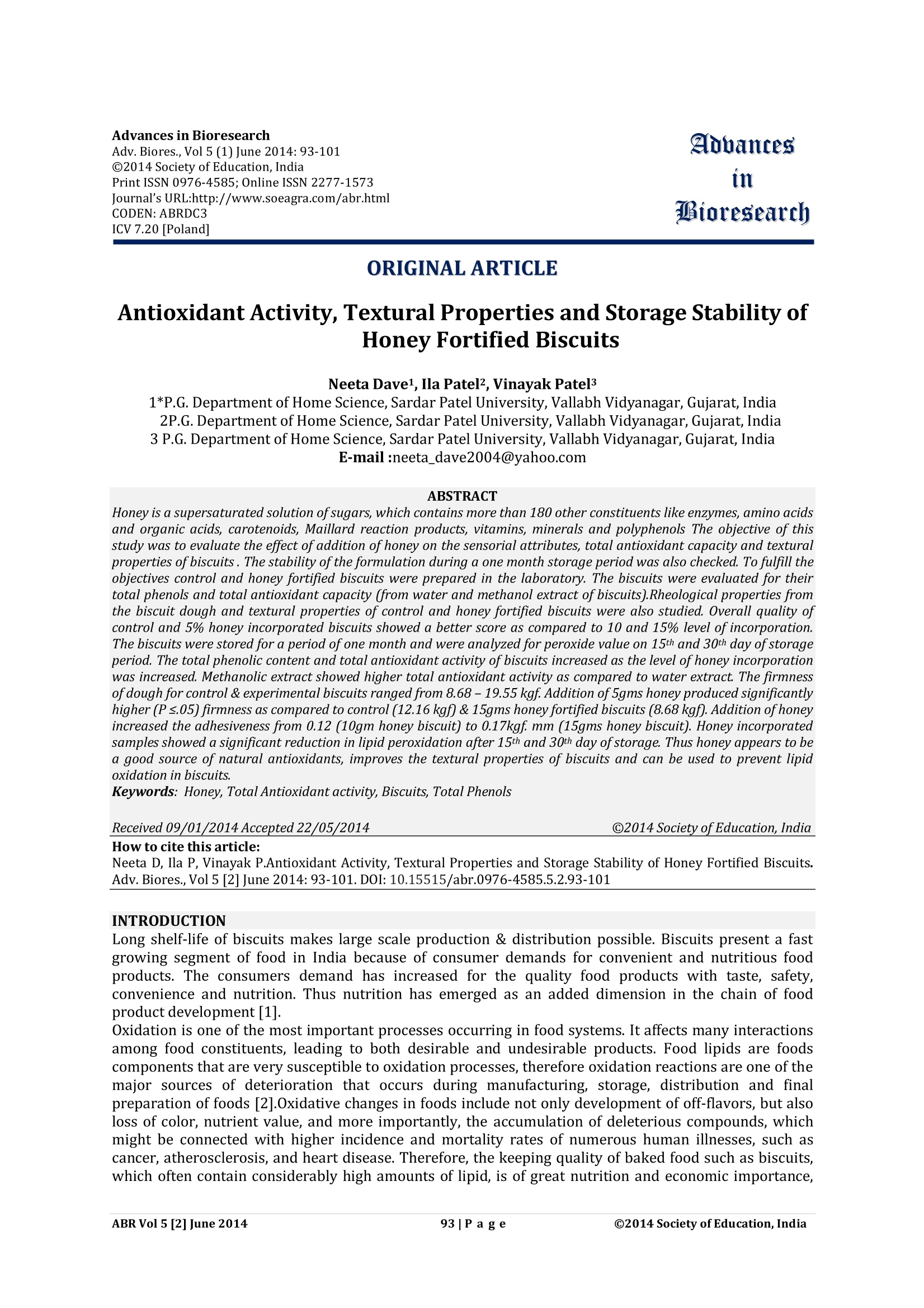
-
2/9
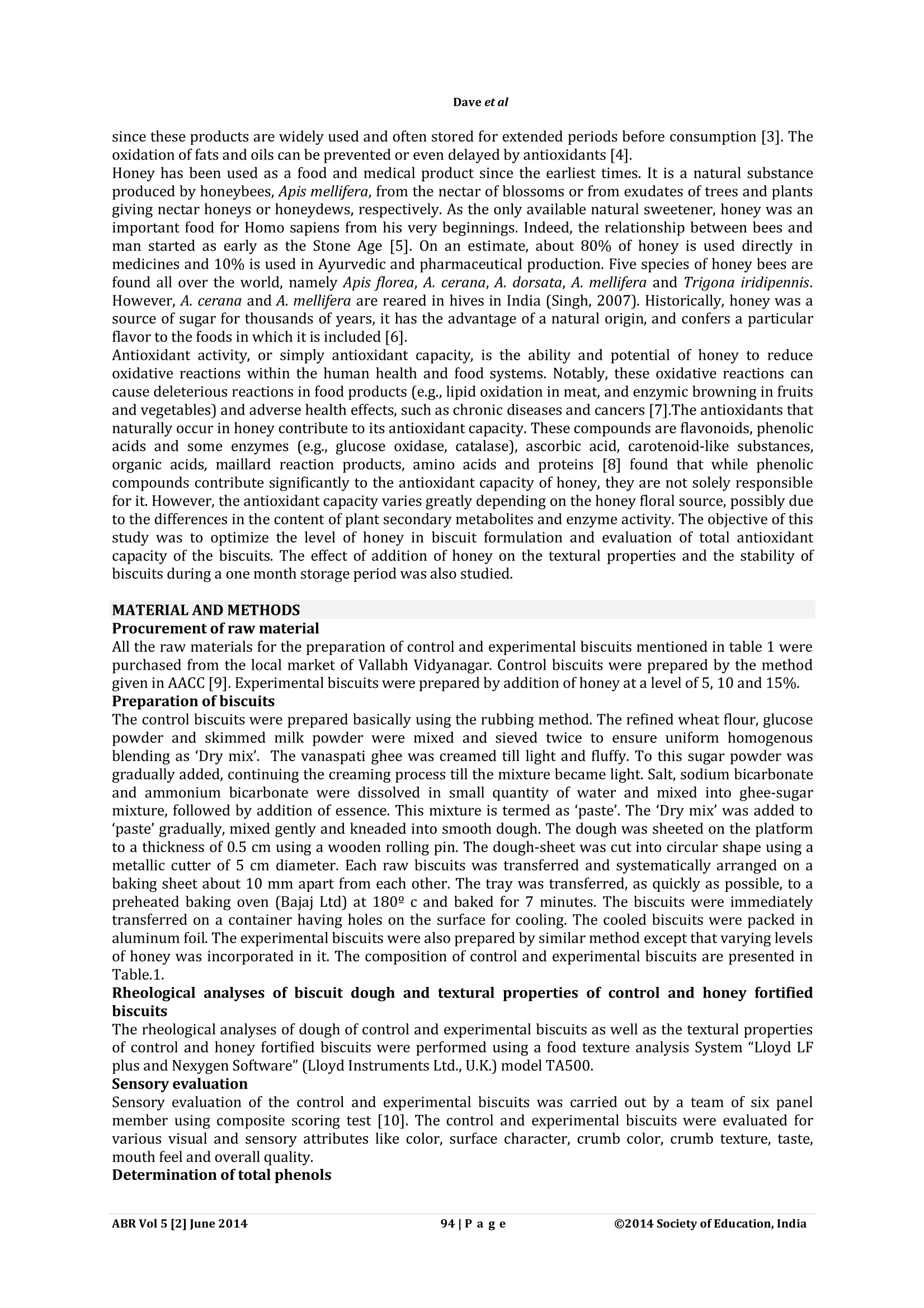
还剩7页未读,是否继续阅读?
继续免费阅读全文产品配置单
云谱仪器(上海)有限公司为您提供《铚傝湝寮哄寲楗煎共中鐗╂€ф娴?IndustryName1=检测方案(质构仪)》,该方案主要用于铚傝湝寮哄寲楗煎共中鐗╂€ф娴?IndustryName1=检测,参考标准《暂无》,《铚傝湝寮哄寲楗煎共中鐗╂€ф娴?IndustryName1=检测方案(质构仪)》用到的仪器有LLOYD TA1质构仪(物性分析仪)。
我要纠错
推荐专场
相关方案
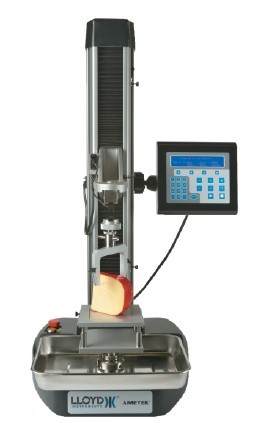

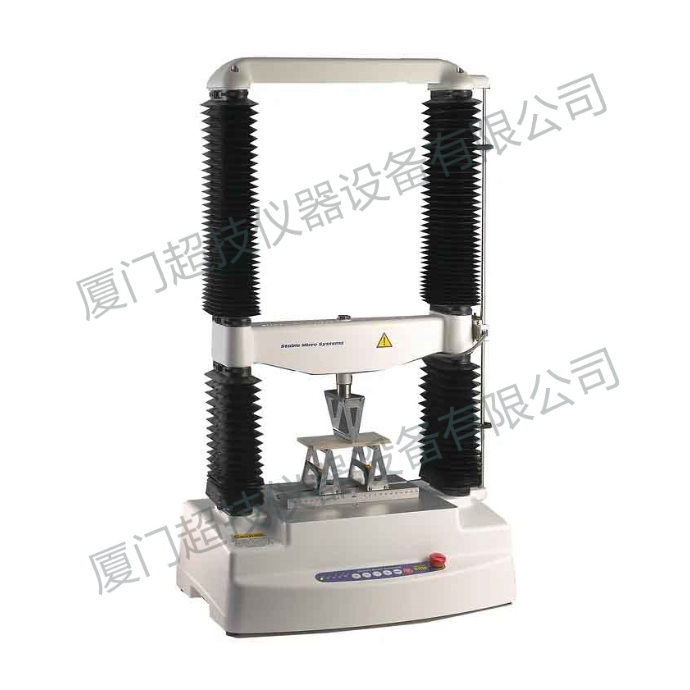
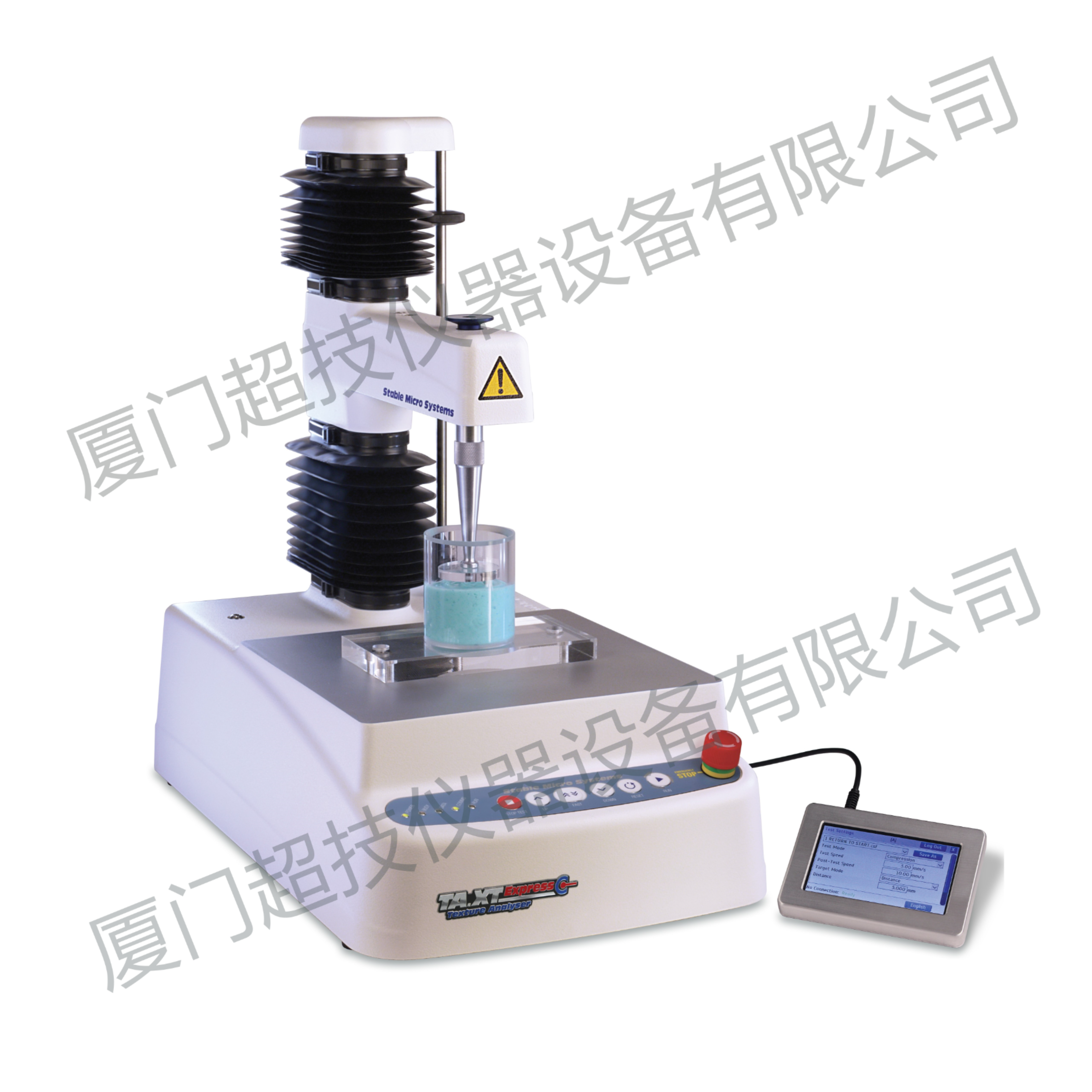
 咨询
咨询